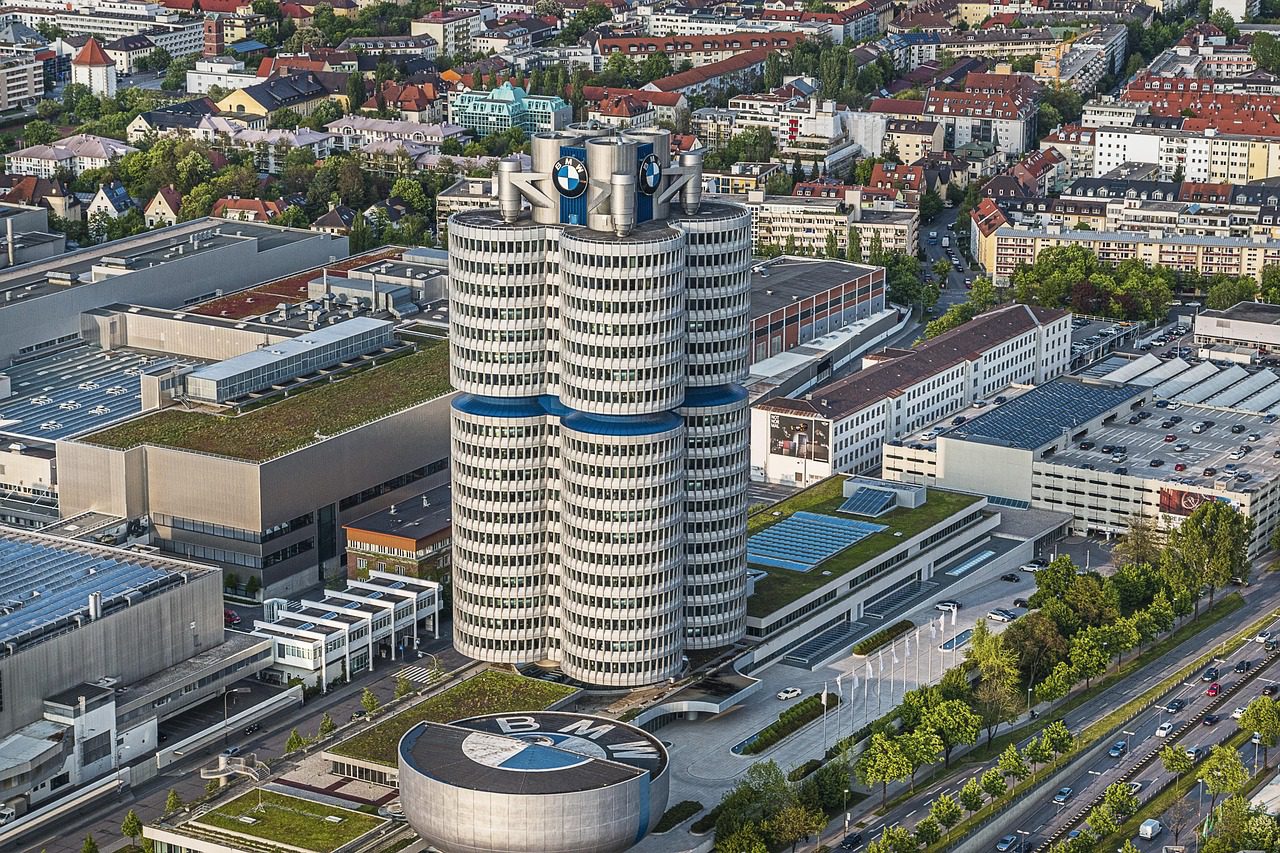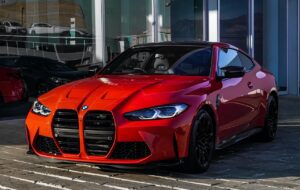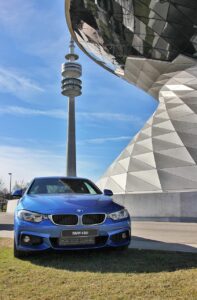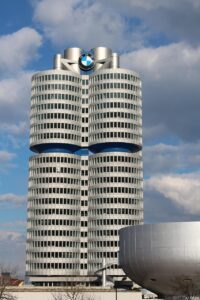
BMW: The Story, Innovation, and Global Legacy
BMW, or Bayerische Motoren Werke AG, is one of the best automobile makers in the world. It is associated with luxury, innovation, and performance. Its English translation is “Bavarian Motor Works.”. The company started more than a century ago in Germany. BMW over time became an international brand representing power, technology, and comfort. BMW vehicles today are seen all over the world—from Europe’s roads to Asia’s cities. BMW is not only about manufacturing cars. It is also about perseverance, engineering, and passion for cars.
Origins of BMW
BMW was founded in 1916 in Munich, Germany. The company didn’t produce cars in the beginning. It produced airplane engines during World War I. After the war, BMW’s direction shifted. According to the Treaty of Versailles, Germany was not allowed to build airplane engines. So, BMW started producing motorcycles in the 1920s. Its first motorcycle, the R32, came out in 1923. It was a huge success. In 1928, BMW acquired a small car company called Dixi. That was the break point. For the first time, BMW began manufacturing cars. The cars were small and economical. People adored them for their looks and functionality.
BMW Before World War II
During the 1930s, BMW became a symbol of innovation. BMW created powerful sports cars and motorcycles. Some of them even won races. Meanwhile, BMW was also producing airplane engines again as Germany remilitarized. The engines were the best available at the time. However, when World War II erupted, BMW factories were working around the clock to produce military equipment. The war concluded in devastation. BMW factories were bombed. Its production stopped. After 1945, Germany was devastated, and BMW was again banned from producing airplane engines. The company experienced its worst moment.
Post-War Recovery
After the war, BMW was restarted from the ground up. The majority of the staff had disappeared, and machinery was wrecked. The firm resumed production on a gradual scale through the production of kitchen utensils, bicycles, and tiny engines. BMW began to produce motorcycles in 1948. Subsequently, in 1952, automobile production began with the BMW 501, a luxury saloon. Early sales were, however, weak. By the late 1950s, BMW had hit rock bottom financially. Another German company, Daimler-Benz (Mercedes-Benz), tried to buy it out. But employees and investors resisted. With new leadership and investment, BMW held on by its fingernails. It was a turning point. It was the beginning of BMW’s transformation into luxury powerhouse.
The Rise of the Modern BMW (1960s–1980s)
In the 1960s, BMW launched its legendary “New Class” (Neue Klasse) series. These cars were sexy, elegant, and reliable. They appealed to professionals who wanted luxury and power. Models like the BMW 1500, 1800, and 2002 turned into cult classics. These saved the company and made it famous across the globe. The 2002 model in specific symbolized BMW’s modern image—small, gorgeous, and strong. BMW expanded in the 1970s. BMW introduced its iconic 3 Series, 5 Series, and 7 Series. The cars remain the heart of BMW today. BMW also introduced the BMW Motorsport division, or M Division, which created high-performance versions of its cars. Its first was the BMW M1, a supercar that amazed enthusiasts all over the world. By the 1980s, BMW was equated with “The Ultimate Driving Machine.” Its cars represented success, freedom, and accuracy.
Innovation and Expansion (1990s–2000s)
The 1990s were decades of international growth. BMW expanded to new markets and introduced additional sophisticated technology. BMW purchased the Rover Group in the United Kingdom, which includes Mini and Land Rover, in 1994. The deal did not go as planned. BMW sold Rover and Land Rover later but kept the Mini brand. The new Mini Cooper was a global hit in the 2000s. In 1998, BMW also took over ownership of Rolls-Royce Motor Cars, a symbol of luxury. This added another dimension to its brand portfolio. BMW went on increasing its designs and sustainability features. In the 2000s, BMW made significant investments in electric mobility and lightweight materials.
BMW in the 21st Century
In the 21st century, BMW is a leader in automobile technology. BMW has diversified manufacturing in many countries, such as the USA, China, and South Africa. BMW introduced the “EfficientDynamics” strategy to integrate high performance with environmental-friendliness. The strategy led to more efficient engines and the introduction of electric vehicles and hybrid cars. BMW introduced the i3 (electric city car) and i8 (plug-in hybrid sports car) in 2013. They revolutionized things. They used carbon-fiber bodies, cyberpunk aesthetics, and advanced technology. Today, BMW leads the way with its BMW iX, i4, and i7 electric vehicles. The models are an expression of the brand’s commitment to a cleaner tomorrow.
BMW’s Design Philosophy
BMW cars stand out in appearance. Every model boasts the brand’s badge—aggressive, elegant, and practical. The unmistakable sign is the kidney grille, an emblem of potency and heritage. Even in electric models, BMW gives this design life. Inside, BMW combines luxury with simplicity. The car is driver-focused. All controls are within easy access. The materials used are luxury-level—leather, metal, and modern fabrics. BMW is also the market leader in digital innovation. Innovations like iDrive, voice control, and heads-up displays create a seamless driving experience.
BMW Models and Their Strength
BMW 1 Series 
BMW 1 Series is the beginning vehicle of BMW’s portfolio. The vehicle is fashionable as well as functional and is a compact car. The 1 Series is mainly designed to drive in the city but is also enjoyable to drive on highways.
Strengths:
- Easy-to-drive compact dimensions for maneuvering through crowded city roads. Front-wheel-drive layout for economy and stability. Comfortable interior trim and modern infotainment system.
- Equipped with frugal turbocharged engines for performance and fuel efficiency. Young professionals are attracted to this model because of its small but posh car feature with the BMW logo.
BMW 3 Series – The Iconic Sports Sedan
The BMW 3 Series is perhaps the firm’s most famous and best-selling model. It combines luxury, comfort, and sporty handling. The 3 Series has been the benchmark for compact executive cars in recent decades.
Strengths:
- A balanced combination of performance and fuel efficiency. Rear-wheel-drive (or all-wheel-drive xDrive) delivers outstanding handling. High-tech interior with large digital displays and BMW’s iDrive system.
- Great resale value and vast service network across the world. The 3 Series will appeal to drivers who love a sporty but practical luxury sedan.
BMW 5 Series – Luxury Meets Performance
BMW 5 Series is a bigger executive sedan that provides comfort, space, and performance. It’s ideal for business executives and road trip drivers.
Strengths:
- Immersive luxury with leather finish and sound insulation. Equipped with powerful engines, including plug-in hybrid. Smooth ride comfort with adaptive suspension.
- Intelligent driving assistance and partial autonomous feature. This car is perfect for those who want luxury, comfort, and the latest technology in a single car.
BMW 7 Series – The Flagship of Luxury
The BMW 7 Series is the definition of BMW luxury. It is a full-size vehicle designed to compete with other luxury cars like the Mercedes-Benz S-Class and Audi A8.
Strengths:
- Extremely comfortable interior with massage seats, ambient lighting, and enormous entertainment screens. Advanced hybrid and electric variants (like the BMW i7). Smooth, hushed ride with top-shelf soundproofing.
- Cutting-edge autonomous driving technologies and gesture control. The 7 Series is a paragon of prestige and sophistication and a first choice for business executives and VIPs.
BMW X3 – The Popular Mid-Size SUV
The BMW X3 is the top-selling BMW SUV in the world. It offers the perfect balance between performance, comfort, and size.
Strengths:
- Spacious interior and large cargo area. Smooth handling and quick acceleration. Available in a variety of trims, including hybrid and M performance models.
- Slimmest design with premium materials inside. The X3 combines functionality with typical BMW driving experience.
BMW X5 – The Versatile Luxury SUV
The BMW X5 is BMW’s most practical vehicle. It’s larger and more powerful than the X3 and offers luxurious family motoring.
Advantages:
- Powerful engine range, including plug-in hybrids and V8 engines. Luxurious interior with ambient illumination and panoramic roof that can be personalized. Excellent off-road capabilities and towing capacity.
- Advanced safety features and driver assistance. This SUV is perfect for families who want power, space, and luxury in a single vehicle.
BMW X7 – The Luxury Flagship SUV
The BMW X7 is BMW’s biggest SUV and an icon of luxury. It combines the size of an SUV with the luxury of a limousine.
Strengths:
- Three rows of seating for seven passengers. Luxurious interior with premium materials and trim. Smooth ride and quiet cabin.
- Potent engine versions and advanced xDrive all-wheel drive. The X7 is for those who require maximum room and uncompromising comfort.
BMW Z4 – The Stylish Roadster
The BMW Z4 is a two-seat roadster providing open-top driving pleasure with added sporty dynamics.
Strengths:
- Convertible roof for thrilling driving. Lightweight body with high-torque engine variants. Spontaneous handling and direct steering.
- Sporty interior with driver-focused controls. The Z4 is ideal for speed enthusiasts, fashionistas, and open-air driving enthusiasts.
BMW M Series – The Performance Legends
BMW M Series is the high-performance division of BMW. The M2, M3, M4, M5, and M8 models are optimized for top power and accuracy.
Strengths:
- Engine with high horsepower optimized for track and road. Sophisticated suspension and braking systems.
- Sporty appearance and aerodynamics with unique features. Unparalleled acceleration and handling. These cars are meant for those drivers who want the ultimate driving experience.
BMW i Series – The Future of Electric Mobility
The BMW i Series is all about electric and hybrid cars. Cars like the BMW i3, i4, iX3, iX, and i7 depict BMW’s promise towards clean mobility.
Advantages:
- 100% electrically driven with zero emissions. Longer battery range and fast charging amenities. Contemporary design and sustainable interior materials.
- Latest autonomous and connectivity technology. i Series embodies BMW’s vision for a future with fewer emissions.
BMW 8 Series – Grand Luxury Coupe
BMW 8 Series blends the potency of a sports car and the elegance of a grand tourer.
Strengths:
- Robust V8 and hybrid powerplants. Sleek look with angular lines and aggressive front grille. Indulgent interior and pinpoint handling.
- Available in coupe, convertible, and Gran Coupe body styles. This vehicle is the artistic and emotional design of BMW.
- BMW’s lineup of cars is the pinnacle of “The Ultimate Driving Machine.” From sports cars to SUVs and sedans, BMW has something for every type of driver. The focus of the company on driving pleasure, engineering, and innovation has made it a standard of excellence in the global automobile sector.
BMW and Sustainability
Sustainability is a very important concern for BMW. The company aims to be carbon neutral by 2050. Factories use renewable energy. Materials are recycled. Electric car production is expanding rapidly. BMW’s Battery Competence Centre in Germany is engaged in developing high-performance batteries for future models. BMW also invests in hydrogen fuel technology. This change signals BMW’s drive to balance luxury with responsibility.
BMW’s Competitors
The automobile industry is fiercely competitive. BMW competes with established and new auto brands.
Mercedes-Benz
BMW’s biggest rival for decades. Both German titans fight for luxury and innovation dominance. Mercedes’ point is comfort and design, while BMW’s is sportiness and driving enjoyment.
Audi
Another dominant German rival. Audi is a leader in technology, from its Quattro system to tidy interior styling. Audi and BMW fight in electric mobility and premium SUV niches.
Tesla
The American brand Tesla leads in electric cars. Model S and Model 3 have taken the industry by storm. BMW i-series is a direct rivalry to Tesla when it comes to innovation and eco-friendliness.
Lexus (Toyota)
Lexus offers luxury cars renowned for reliability and comfort. BMW has more performance vehicles, whereas Lexus aims for refinement and reliability.
Jaguar and Land Rover
These British brands compete in the premium sedan and SUV markets. BMW leads in technology and performance.
Porsche
Porsche, famous for high-performance sports cars, competes with BMW sports models and M Series.
Volkswagen
Volkswagen is more mass market but shares the same technology roots as Audi. Both brands compete with BMW in global sales.
BMW in Motorsports
BMW’s performance love affair is based on its racing history. BMW has participated in Formula 1, Touring Cars, and Endurance Racing. Motorsport allows BMW to experiment with new technologies. The majority of its breakthroughs—lightweight materials and high-performance engines—started on the race track. BMW’s M Division continues this tradition. The M4 GT3 and M8 GTE are witness to engineering maturity.
BMW and the Future
The future of BMW is electric and digital. Billions are invested by the company in research. It works on autonomous driving, AI technology, and connected vehicles. The new “Neue Klasse” platform (coming 2025) will change everything. It combines new battery technology, minimalist design, and full connectivity. BMW also works with partners like Intel and Mobileye for autonomous systems. The vision of the company is clear: smart cars that are fast, smart, and green.
Conclusion
The history of BMW is one of innovation, perseverance, and perfection. From aircraft engines to electric cars, BMW has evolved with the times but kept its essence whole. It survived wars, crises, and cutthroat competition. It still inspires car enthusiasts globally. BMW’s motto, “The Ultimate Driving Machine,” is not an exaggeration. It’s about precision, passion, and innovation. As the world is moving towards sustainability and digital mobility, BMW leads with vision and strength. Wherever you drive a 3 Series in Europe or an iX in Asia, you feel the same passion — the thrill of the road, the beauty of design, and the promise of tomorrow.













